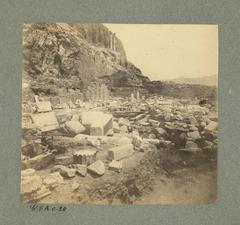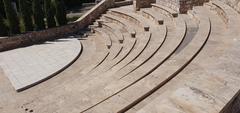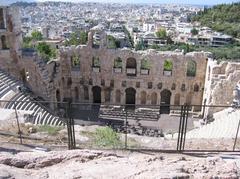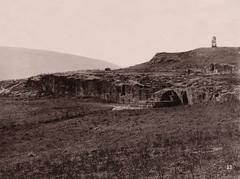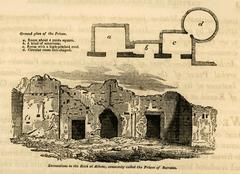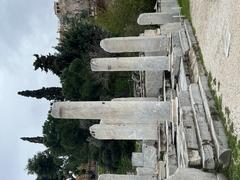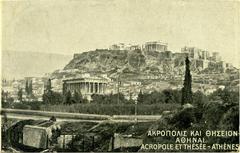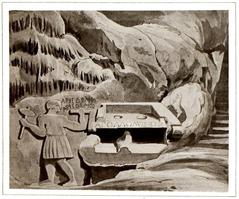Visiting Hours, Tickets, and Travel Tips for Μουσείο Ακρόπολης in Athens, Greece
Publication Date: 16/07/2024
Introduction to Μουσείο Ακρόπολης
The Acropolis Museum in Athens, Greece, stands as a beacon of ancient Greek civilization, encapsulating the grandeur, sophistication, and historical significance of the Acropolis itself. Established to preserve and exhibit the remarkable artifacts from the ancient citadel, the museum is an architectural marvel designed by Bernard Tschumi and Michael Photiadis. Since its inauguration on June 20, 2009, the museum has been pivotal in both the cultural and educational spheres, offering visitors a profound glimpse into ancient Greek history through its meticulously curated collections. The museum’s design harmoniously blends modernity with tradition, featuring expansive glass windows that provide stunning views of the Acropolis, thus creating a seamless connection between the artifacts and their original context (Acropolis Museum Official Website).
The museum’s role extends beyond mere preservation; it actively participates in the ongoing global debate over the repatriation of cultural artifacts, particularly the Parthenon Marbles. This makes it not only a center for historical artifacts but also a symbol of national pride and cultural heritage. Additionally, the museum incorporates advanced technologies such as 3D scanning and virtual reality to enhance the visitor experience, making it a leader in integrating technology into cultural preservation. Whether you’re a history enthusiast, a student, or a casual visitor, the Acropolis Museum offers a comprehensive, enriching experience that deepens your understanding of ancient Greek culture and its lasting impact on the world (Acropolis Museum - History, Visiting Hours, Tickets, and More).
Table of Contents
- Introduction
- History of the Acropolis Museum
- Exhibitions and Collections
- Technological Innovations
- Cultural and Educational Impact
- Preservation and Conservation Efforts
- Visitor Information
- FAQ
- Conclusion
A Complete Guide to Visiting the Acropolis Museum in Athens
History of the Acropolis Museum
Origins and Early Development
The idea of creating a museum to house the Parthenon sculptures dates back to the 19th century. The initial impetus for the museum’s creation was the need to protect the artifacts from the elements and the growing urban environment of Athens. The first Acropolis Museum was established in 1874 on the Acropolis itself, but it soon became apparent that a larger, more modern facility was needed.
Architectural Vision and Construction
The current Acropolis Museum, designed by Swiss architect Bernard Tschumi in collaboration with Greek architect Michael Photiadis, is a testament to modern design and functionality. Construction began in 2003 and was completed in 2007, with the museum officially opening its doors to the public on June 20, 2009. The building’s design is characterized by its use of natural light, open spaces, and a layout that mirrors the topography of the Acropolis itself.
Key Historical Milestones
Discovery and Excavation
During the construction of the museum, extensive archaeological excavations revealed a wealth of artifacts and structures dating from the Archaic to the Byzantine periods. These findings are now an integral part of the museum’s exhibits.
The Parthenon Marbles Controversy
One of the most significant historical aspects of the Acropolis Museum is its role in the ongoing debate over the Parthenon Marbles. These sculptures, originally part of the Parthenon, were removed by Lord Elgin in the early 19th century and are currently housed in the British Museum. The Acropolis Museum was designed with the explicit intention of providing a suitable home for these marbles, should they ever be returned to Greece. The museum’s top floor, known as the Parthenon Gallery, is specifically designed to display the marbles in their original context, with a direct view of the Parthenon itself.
Exhibitions and Collections
Permanent Collections
The Acropolis Museum’s permanent collection is divided into several thematic sections, each representing different periods of ancient Greek history. Key exhibits include the Caryatids, the Parthenon frieze, and the statues of the Parthenon pediments.
Temporary Exhibitions
In addition to its permanent collection, the Acropolis Museum hosts a variety of temporary exhibitions that explore different aspects of ancient Greek culture and history. These exhibitions often feature artifacts on loan from other museums and institutions.
Technological Innovations
The Acropolis Museum employs a range of digital tools and interactive displays to enhance the educational value of its exhibits. These include 3D reconstructions, virtual reality experiences, and multimedia presentations that provide context and background information on the artifacts and their historical significance.
Cultural and Educational Impact
Educational Programs
The Acropolis Museum offers a variety of programs for visitors of all ages, including guided tours, workshops, and educational activities. The museum also collaborates with schools and educational institutions to provide tailored programs for students.
Cultural Events
The museum regularly hosts cultural events, including lectures, performances, and special exhibitions, that celebrate and promote Greek heritage.
Preservation and Conservation Efforts
The Acropolis Museum employs a team of conservators who use state-of-the-art techniques to ensure the long-term preservation of the collection. This includes regular monitoring and maintenance of the artifacts, as well as research into new conservation methods.
Visitor Information
Tickets and Visiting Hours
- Opening Hours - The museum is open daily. Check the official website for current visiting hours.
- Tickets - General admission tickets are available online and at the museum. Discounts are offered for students, seniors, and groups. Purchase tickets online.
Travel Tips
- Location - The Acropolis Museum is located at 15 Dionysiou Areopagitou Street, Athens, Greece.
- Accessibility - The museum is accessible to visitors with disabilities, offering ramps, elevators, and accessible restrooms.
- Nearby Attractions - The Acropolis, Parthenon, and the Odeon of Herodes Atticus are within walking distance.
- Guided Tours - Consider booking a guided tour to enhance your visit. Learn more about tours.
FAQ
What are the Acropolis Museum’s opening hours?
- The museum is open daily. Check the official website for current visiting hours.
How much do tickets to the Acropolis Museum cost?
- General admission tickets are available online and at the museum. Discounts are offered for students, seniors, and groups. Purchase tickets online.
What is the best way to get to the Acropolis Museum?
- The museum is easily accessible via the Acropolis Metro Station. It’s recommended to arrive early and consider guided tours for a richer experience.
Conclusion
The Acropolis Museum is a vital part of Greece’s cultural landscape, offering visitors a unique insight into ancient Greek history and art. By understanding the history and significance of the museum, visitors can gain a deeper appreciation for the artifacts it houses and the stories they tell about ancient Greece. Whether you’re a history enthusiast or a casual visitor, the Acropolis Museum is a must-visit destination in Athens.
For more information and updates, follow the Acropolis Museum on social media or download the museum’s mobile app Audiala.

